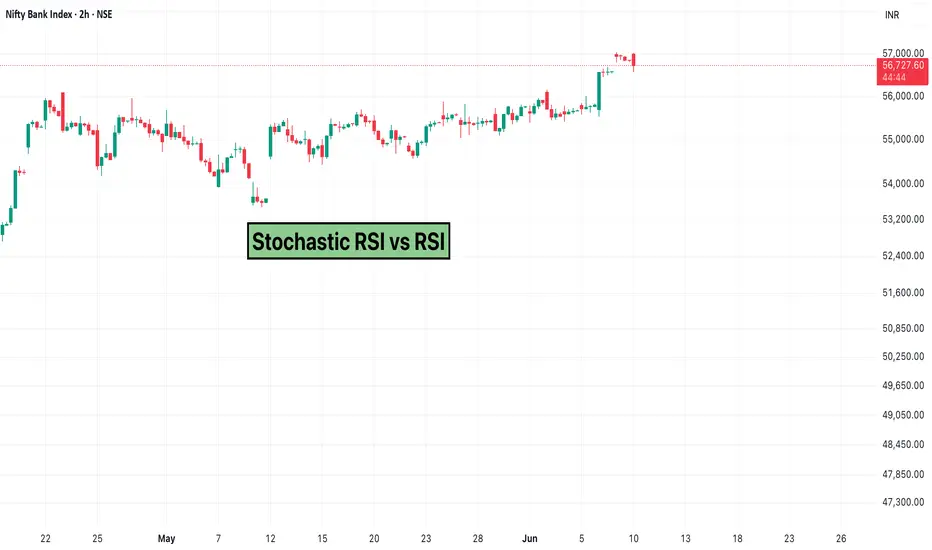When it comes to momentum indicators on TradingView, both RSI and Stochastic RSI offer valuable insights but they operate differently and serve slightly different purposes.
What is RSI?
The Relative Strength Index (RSI) is a momentum oscillator that measures the speed and magnitude of recent price changes. It ranges from 0 to 100:
What is Stochastic RSI?
The Stochastic RSI applies the stochastic formula to RSI values, not price directly. It’s essentially an indicator of an indicator:
Key Differences
When to Use Each
Conclusion
There’s no “one-size-fits-all” answer—both RSI and Stochastic RSI have their strengths. The best choice depends on your trading style, timeframe, and risk appetite. Used together, they can offer both big-picture context and precise timing.
What is RSI?
The Relative Strength Index (RSI) is a momentum oscillator that measures the speed and magnitude of recent price changes. It ranges from 0 to 100:
- RSI above 70 suggests overbought conditions.
- RSI below 30 indicates oversold conditions.
- Often used for spotting reversals, momentum shifts, or trend strength.
What is Stochastic RSI?
The Stochastic RSI applies the stochastic formula to RSI values, not price directly. It’s essentially an indicator of an indicator:
- It oscillates between 0 and 1 (or 0 to 100 when scaled).
- Helps identify short-term overbought/oversold levels in RSI itself.
- More sensitive and quicker to respond than traditional RSI.
Key Differences
- Calculation: RSI uses price data directly; Stochastic RSI uses RSI values.
- Speed: Stochastic RSI reacts faster, which can lead to earlier signals—but also more noise.
- Use Case: RSI is better for identifying broader momentum; Stochastic RSI excels in short-term setups and fine-tuning entries.
When to Use Each
- Use RSI when you want a stable, reliable view of momentum—especially for swing or position trading.
- Use Stochastic RSI when you’re looking for short-term setups or want to confirm entries in choppy conditions.
- Some traders use both together: RSI for the overall signal, and Stochastic RSI to time the entry more precisely.
Conclusion
There’s no “one-size-fits-all” answer—both RSI and Stochastic RSI have their strengths. The best choice depends on your trading style, timeframe, and risk appetite. Used together, they can offer both big-picture context and precise timing.
Elevate your Trading Experience 🚀
📱 Download Dhan App on iOS and Android and Start Trading.
📱 Download Dhan App on iOS and Android and Start Trading.
Penafian
Maklumat dan penerbitan adalah tidak dimaksudkan untuk menjadi, dan tidak membentuk, nasihat untuk kewangan, pelaburan, perdagangan dan jenis-jenis lain atau cadangan yang dibekalkan atau disahkan oleh TradingView. Baca dengan lebih lanjut di Terma Penggunaan.
Elevate your Trading Experience 🚀
📱 Download Dhan App on iOS and Android and Start Trading.
📱 Download Dhan App on iOS and Android and Start Trading.
Penafian
Maklumat dan penerbitan adalah tidak dimaksudkan untuk menjadi, dan tidak membentuk, nasihat untuk kewangan, pelaburan, perdagangan dan jenis-jenis lain atau cadangan yang dibekalkan atau disahkan oleh TradingView. Baca dengan lebih lanjut di Terma Penggunaan.
